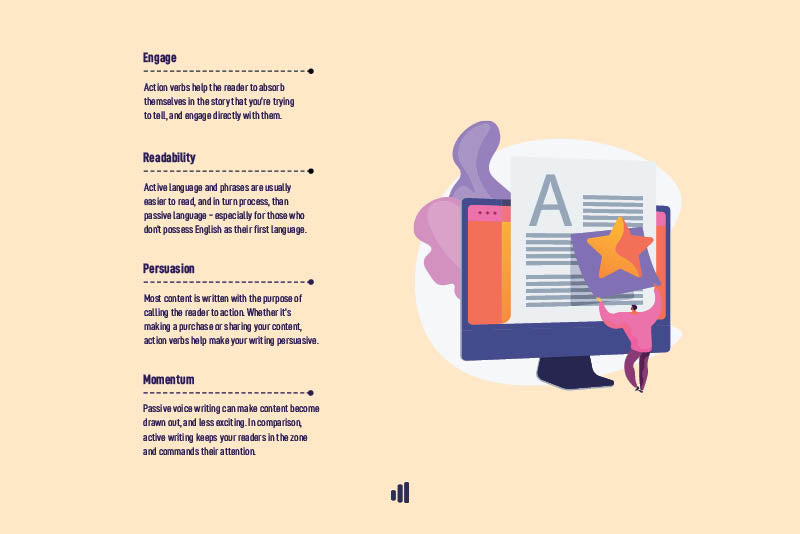When it comes to your brand’s written marketing efforts, do you know how to deploy active voice text to ensure that the message packs a punch?
Let’s face it – writing can be hard, and certainly doesn’t come naturally to everyone. Conveying the thoughts bouncing around in your mind into tangible text can be difficult, especially if it’s not something that you do regularly. When you’re busy trying to steer the ship or focus on your products or services, blogging for business can be even more arduous – which is often why commerce websites forgo having a blog at all.

However, failing to blog or post articles regularly ignores the fundamental principles of SEO, or search engine optimisation. If you aren’t blogging regularly, you risk being overtaken by your competition on the search engine ranks – even if they lack the quality or experience that your brand may provide. In saying that, writing for marketing is somewhat of a fine art – so why would you bother with trying to conquer active voice content?
Why The Active Voice Matters In Marketing
Using the active voice in the marketing realm conveys a strong, clear and authoritative tone. In comparison, using the passive voice can come across as less confident, subtler and ultimately weaker. Some good advice for budding wordsmiths is this – don’t use the passive voice just because you think it sounds a bit fancier than the active voice.
When it comes to writing for commerce based content marketing, using active voice in the text body helps to –
Engage – Action verbs help the reader to absorb themselves in the story that you’re trying to tell, and engage directly with them.
Readability – Active language and phrases are usually easier to read, and in turn process, than passive language – especially for those who don’t possess English as their first language.
Persuasion – Most content is written with the purpose of calling the reader to action. Whether it’s making a purchase or sharing your content, action verbs help make your writing persuasive.
Momentum – Passive voice writing can make content become drawn out, and less exciting. In comparison, active writing keeps your readers in the zone and commands their attention.
Connection – Written web content should be informative, and easy to digest. Too much passive writing can make your work feel academic, and in turn alienate readers.

When using active voice to construct web text, blogs and articles, you’re also able to create a faster moving narrative for your audiences. More often than not, it’s less stiff, cleans up the sentence structure, and even helps to prevent grammatical mistakes – so how do you get it right?
A Guide To Active Voice Writing
The active voice describes a sentence where the subject performs the action stated by the verb. It follows a clear subject + verb + object construct that’s easy to read. Sentences constructed in the active voice add impact to your writing, and in a business context, can go a long way when it comes to encouraging your readers to take action. One of the best modern examples of well executed active voice writing is Nike’s iconic “Just Do It”.
The opposite of active voice writing is passive voice writing, with the latter generally not considered to be a friend of marketing professionals. Passive voice produces a sentence in which the subject receives an action. In contrast, an active voice produces a sentence in which the subject performs an action.
An easy way to identify active voice writing is that the subject is often “doing” the verb. The aim of the game is to capture their attention, and help them to visualise the message you’re trying to convey. To summarise the key difference between writing with an active voice over a passive voice, try to remember the following.
Active Voice = Subject + Verb + Object. Tell your audience what a person, item or object does. The subject performs the action (verb) on the object.
Passive Voice = Object + Verb + Subject. This is defined by telling your audience what is done to someone or something. The subject is being acted upon.
To change a sentence from passive to active voice, determine who or what performs the action, and use that person or thing as the subject of the sentence. Another way to think of it is that the subject performs the verb’s action in active voice, whereas the subject receives the verb’s action in passive voice.
Active: Lisa embraced her coffee enthusiastically.
Passive: The coffee was enthusiastically embraced by Lisa.
See the difference? Having a coffee in your hands much like Lisa does, suddenly becomes a lot more appealing and accessible when the text is written with an active voice. Are you inspired to get up and go make or buy a coffee now? If so, consider the job done.
Sourcing Help With Active Voice Writing
Producing quality, consistent and on brand content takes time, effort, experience and resources – and you’re not alone if you can’t quite commit to that. Avoiding blog writing all together may actually be doing your brand a disservice but thankfully, investing in a solid content marketing strategy has never been easier.
Here at Content Hive, producing top quality digital content is exactly what we do best. We have itemised a list of digital content services, and allocated credits next to each of these. This means that each month, you can use your credits with us to produce digital content such as blog articles, social media posts, videos and even animated Instagram stories. By using this model, we believe that it enables us to produce high quality content with faster delivery times. It also means that because you have a monthly credit, you are going to want to make sure you use these up – and so do we – meaning that your digital content is always consistent.
If you aren’t quite sure where to start on your digital marketing journey and would like to speak to a professional, why not book in a free discovery call with us at Content Hive today to discuss how we can get your brand buzzing online.


